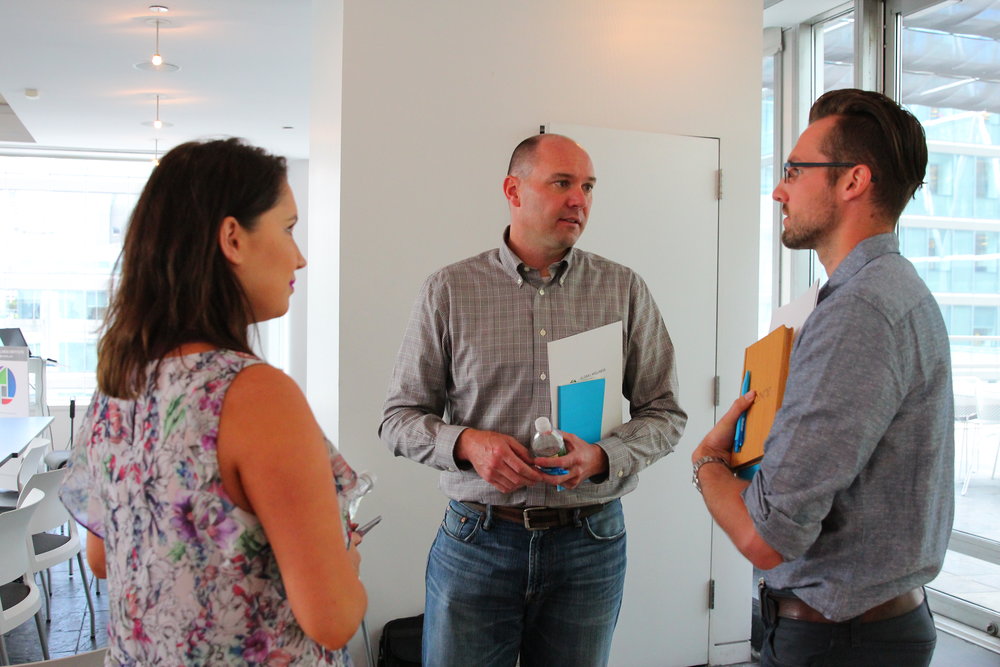THE FUTURE OF WELLNESS IN THE AEC INDUSTRY ROUNDTABLE
June 27, 2017
On June 27, the Wellness Architecture Initiative hosted a roundtable & interactive forum on how designing for human health and wellness will profoundly transform the architecture, engineering and construction (AEC) industries. The discussion was moderated by Veronica Schreibeis Smith, CEO and Founding Principal of Vera Iconica Architecture, and the initiative chair of the Wellness Architecture Initiative.
Read full roundtable report HERE
Key Takeaways:
- The scientific evidence indicates that the built environment affects all dimensions of human wellness: physical, social, mental, occupational, emotional and spiritual. But public awareness of how surroundings impact one’s health seriously lags behind the scientific evidence. Knowledge must be shared much more systematically for people to have the power to choose environments that enhance (and don’t hurt) their health and well-being.
- Now is the time to expand the focus of the architecture, engineering and construction industries from environmental health to human wellbeing. And it’s happening fast, with architects reporting far more interest from public and private clients for everything from biophilic design principles to tackling deadly indoor air pollution to lighting design that boosts mood, sleep and productivity to strategies that block electromagnetic radiation to design that encourages movement and social interaction. They’re working with mayors, workplaces, schools and prisons – even parents of special-needs children. Signs of progress are mounting: for example, Fannie Mae, one of the largest U.S. government-lending housing agencies, just launched the Healthy Housing Rewards initiative, with financial incentives for borrowers who infuse healthy design in new, affordable rental properties, like features that improve air quality, encourage physical activity and interweave community spaces.
- Universities have an ethical (and market) responsibility to train architects and designers to understand the impact of the built environment on human health and well-being as basic knowledge in their design tool belt.
- Today’s building codes frequently result in buildings that are unhealthy, causing people discomfort and illness. Tomorrow’s code requirements should result in benign buildings as a minimum. High-performance buildings of the future must not only achieve net positive environmental impacts, but also nourish the humans that occupy them.
- Developers are starting to see (as with the green building movement) that buildings designed for human wellness are a market differentiator that can boost prices and profits. But panelists agreed that making the economic case for more wellness architecture projects/investment means more high-quality data on cost, impact and ROI – and that pressure to get more government and regulatory bodies involved may prove the most powerful future weapon.
LIST OF PARTICIPANTS:
Michael Armstrong, CEO, NCARB, United States
Sally Augustin, PhD, Principal, Design with Science, United States
Paula Baker-LaPorte, President, EcoNest Architecture, Inc., United States
Wendy Bosalavage, President, LIVunLtd, United States
James Brewer, Workspace Consultant, Steelcase, United States
Ivan Chow, Dean, School of Building Arts, SCAD, United States
Blair Costello McGregor, Office Manager, Vera Iconica Architecture, United States
Jim Cramer, Chairman, Cramer Partners, United States
Anthony DiGuiseppe, Principal, DiGuiseppe Architects, United States
Nicole Dosso, Director, Skidmore, Owings & Merrill LLP, United States
Debra Duneier, President, EcoChi, LLC, United States
Jason Dunlop, Vice President, Big-D Signature, United States
Susie Ellis, Chairman & CEO, Global Wellness Summit, United States
Dr. Mitchell Joaquim, PhD, Co-Founder, Terreform, United States
Mia Kyricos, President & CEO, Kyricos & Associates LLC, United States
Dr. Young Lee, PhD, Director, Innovative Workplace Institute, United States
James May, New York Healthcare Director, NBBJ, United States
James Patten, CEO & Founder, Patten Studios, United States
Meagan Rossi, Senior Director, Delos Solutions, United States
Lindsay S. Burgess, Principal, Enlightened Real Estate, United States
Veronica Schreibeis Smith, CEO & Founding Principal, Vera Iconica Architecture, United States
Giselle Sebag, Director of Programs, The Center for Active Design, United States
Miriam Senft, President & CEO, Motivity Partnerships, Inc., United States
Scott Simpson, Senior Principal, Greenway Group, United States
Brandon Sinclair, Architect, , Canada
Anna Sinclair, Founder, Your Legacy Lifestyle Blog, United States
Linda Sorrento, Principal Sustainable Practice, Sorrento Consulting, LLC, United States
James Stawniczy, Senior Health & Wellbeing Consultant, HOK, United States
Dr. Krishna Talavane, Founder & President, Indus Valley Ayurvedic Centre, India
Katie Wilson, Architect/ Project Manager, Vera Iconica Architecture, United States




























































